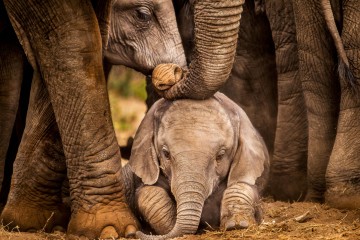
Magical Victoria Falls and Chobe
An unforgettable adventure where you'll experience the spectacular Victoria Falls, enjoy an up-close elephant encounter, and explore renowned Chobe!
Botswana's Chobe National Park is an outstanding destination for wildlife experiences. Famous for its large elephant herds and rich biodiversity, which is fed by the mighty Chobe River, the park is home to a jaw-dropping concentration of land and aquatic wildlife species. Whether you are planning a Chobe day trip from Victoria Falls, a multi-day visit from South Africa, or including it on a longer journey through Botswana, this stellar reserve promises some of the best wildlife viewing of your trip.
Here are the topics we’ll cover in this comprehensive guide:
Chobe is tucked away in the northern corner of Botswana and enjoys a strategic location at the so-called "Four Corners". That’s the point where Botswana borders Namibia, Zimbabwe and Zambia. The park’s unique and central location makes it superbly easy to access.
Combining a Chobe National Park safari with a visit to nearby Victoria Falls (and other top destinations) is easy and time-efficient - great news if you’re on a shorter travel timeline.
> Read More: Victoria Falls - Which Side Should You Visit?
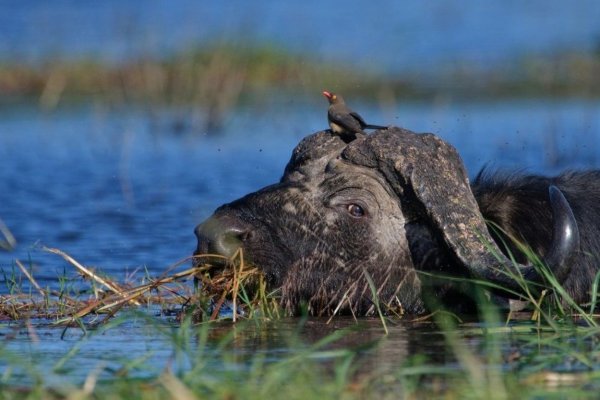
Aside from elephants, Chobe is also home to an impressive Cape buffalo population
The closest town with an airport is Kasane, just a few minutes away from the Sedidi Gate, the park’s main entry point. Kasane’s airport connects to Johannesburg (South Africa) and Maun (for the Okavango Delta), making a side-trip easy from just about anywhere in southern and eastern Africa.
> Read More: How to get to Africa from New Zealand
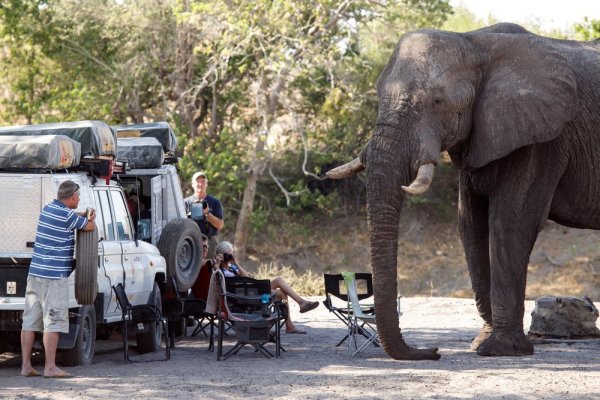
In Chobe, elephants rule!
If elephants are big on your safari bucket list, there’s no better place in Africa to visit.
Botswana is revered for its elephant population, and Chobe is the main reason. Dubbed the "Elephant Capital of the World," the park is home to an estimated 50,000 to 120,000 elephants. Sightings of the gentle giants are virtually guaranteed.
Here are a few more reasons you might want to pin Chobe National Park on your map:
The largest elephant population in Africa.
There are more ellies in this park than any other in Africa. They are often seen in large herds along the Chobe River, especially during the dry season.
It was Botswana’s first national park.
Established in 1968, Chobe set the bar for the country's commitment to land and wildlife conservation, and sustainable tourism.
The ecosystem is incredibly diverse.
The park hosts an impressive array of flora and fauna, from the lush floodplains of the Chobe Riverfront (the most visited region) to the savannas of Savuti, sprawling Linyanti wetlands, and the semi-arid landscape of Nogatsaa.
World-class birdwatching.
With over 450 recorded bird species, Chobe is a birdwatcher's dream. The park offers outstanding year-round birding opportunities, with chances to see fish eagles, kingfishers, carmine bee-eaters, African skimmers, and more.
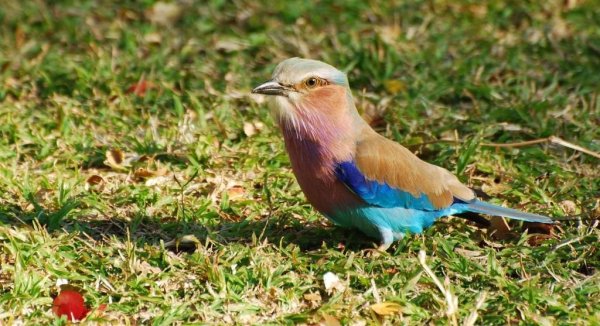
Lilac Breasted Roller, one of the prettiest (in our opinion!) birds in Botswana.
Plenty of big game to be spotted.
Such incredible biodiversity supports an equally impressive array of animals. Plus, big elephants attract big predators. Wildlife spotting chances here are phenomenal, from big cats like lions, cheetahs and leopards to hyenas, impalas, giraffes and even wild dogs.
The Great Zebra Migration.
Chobe hosts one of Africa's lesser-known wildlife spectacles: the Great Zebra Migration. Every year, between November and April, thousands of zebras migrate between Botswana's Nxai Pan and the Chobe River for food and water.
Rare antelope species.
The park is one of the few places in Southern Africa where rare antelope species like sable and roan can be spotted, often seen grazing in the woodlands.
A haven for boat safaris.
Unlike traditional game drives, boat safaris offer closer encounters with hippos, crocodiles, elephants, and giraffes cooling off in the water. Chobe River boat safaris are by far one of its most enticing calling cards.
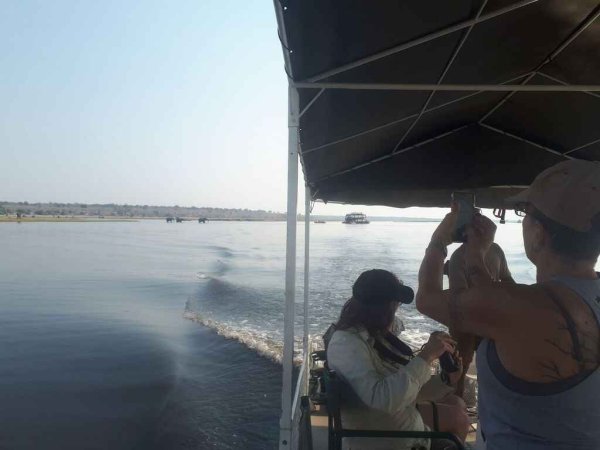
Riverboat safaris in Chobe National Park
As mentioned earlier, Chobe's accessibility is another reason to visit. Being close to Victoria Falls means you can easily add it to your itinerary, even if you're short on time. Chobe day trips to the Riverfront are popular for this reason, but staying overnight allows you to travel further into the park and experience the quieter, more remote areas.
If you’re super short on time, a Chobe day trip is just enough to give you a taste of what this magical place offers. The best area for this is the Chobe Riverfront, easily accessible from Kasane. This is how we plan our Chobe & Victoria Falls Tour - there's plentiful wildlife in this region, and you can experience a game drive and boat safari in one day, so you'll still get an outstanding experience.
While a Chobe day trip is a fantastic introduction to the park, it barely scratches the surface of what this incredible destination offers. If time allows, aim to spend at least two to three days, as we do on our Chobe Encounter Tour. This allows you to experience both game drives and boat safaris in multiple locations without feeling rushed.
The more time you have, the more remote you can go. Spend a night or two exploring the Chobe Riverfront, then venture deeper into the park to areas like Savuti or Linyanti. These regions are less crowded and offer incredible opportunities to see predators and other elusive wildlife without big tourist crowds, but you need more days to explore them fully.
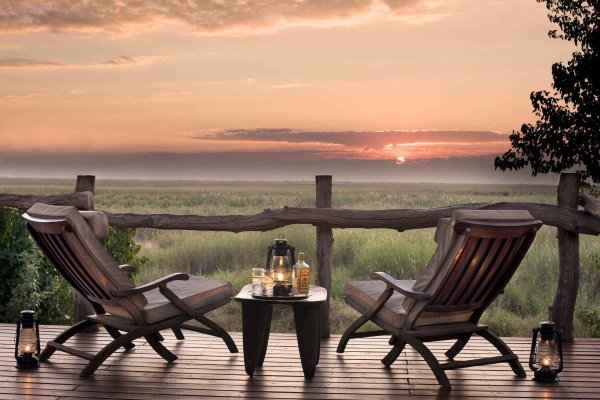
The remote Linyanti Bush Camp offers an extraordinary, off-the-tourist-trail Chobe safari experience, complete with flight transfer.
The ideal time for a Chobe safari experience is the winter—the dry, cool months between May and October.
Winter in Botswana brings clear skies and sparser vegetation, so wildlife congregates around water sources, making spotting them much easier. Choose to stay in a riverside lodge and you could be sipping a sundowner and watching a plethora of animals come to shore to drink - one of Chobe’s most magical experiences.
During the winter, days are comfortably warm, but mornings and evenings can be surprisingly chilly (yes, even in Africa!) If you plan to visit from June to August, pack a jacket for night and early-morning game drives.
Remember, though, that June to October is peak season here, so expect tours and sought-after game lodges to book out fast. If you're looking for a quieter experience, the shoulder months of April, May, November, or December are great. While there might be occasional rain, it's usually brief and manageable, and you'll enjoy more budget-friendly rates too.
Safari attire differs from your run-of-the-mill holiday garb. Out there, you aim to blend in with the landscape, which means opting for clothing in neutral colours like beige, khaki, olive and various shades of tan. Bright and dark colours are magnets for insects, and white is begging for unnecessary (laundry) grief. Between the heat, earthy sand, flicking wet mud, and driving in open 4WD, the main priority for your gear is that it should be comfortable and practical. Things don’t stay pristine very long. Pockets rule, as do hats and warm jackets for cooler evenings.
If you're planning a fly-in safari to a remote lodge, remember to enquire about the luggage weight limit—those light planes are usually pretty strict on baggage allowances.
Find out more about what to wear, and pack right here:
> Read more: What to Wear on Safari
Chobe is one of Africa’s premier safari playgrounds, teeming with wildlife at every turn.
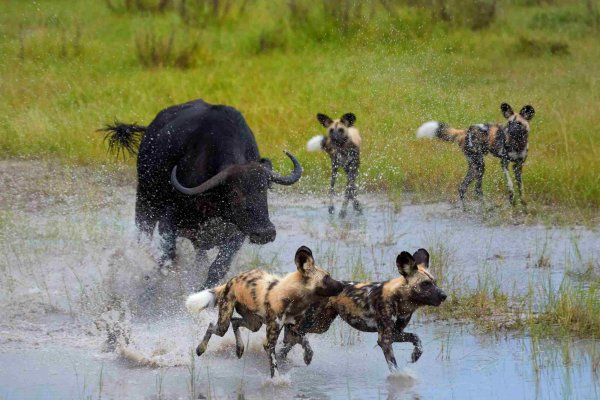
Cape buffalo & wild dogs in Chobe - visit for the elephants and get overawed by everything else.
Game drives take you through diverse landscapes, from open plains to woodland areas, each offering its own set of animal-spotting chances. Our crew here at Viva has spotted wild dogs on the hunt, leopards climbing trees, lions guarding a fresh kill, giraffes, various species of antelopes, and so much more. And, of course, elephants—entire extended families roaming the park.
⁜ Big Cats: Lions are commonly spotted, particularly in the Savuti Marsh, where they’ve been known to hunt elephants. Leopards are also frequently seen, often draped elegantly in the branches of acacia trees.
⁜ Wild Dogs: Chobe is one of the few places where you might catch a glimpse of these endangered predators.
⁜ Herbivores: Giraffes, zebras, and an array of antelopes, including kudu, sable, and roan, live in the park.
⁜ Aquatic Life: The Chobe River has crocodiles, hippos, and the occasional tigerfish leaping from the water.
⁜ Birdlife: Chobe is a birder’s paradise. Look out for African fish eagles, malachite kingfishers, and the iconic carmine bee-eaters.
Boat safaris along the Chobe River offer an entirely different perspective. Watching elephants cross the river, spotting hippos popping up for air, or witnessing crocodiles sunning themselves on the banks is simply unforgettable.
As with any game drive or riverboat safari in a wild and unpredictable environment, you never know what kind of wildlife experience is in store on any given day. That's all part of the thrill.
How Does Chobe Differ from the Okavango Delta?
While both Chobe and the Okavango Delta are must-visit destinations in Botswana, they do offer distinctly different experiences. Chobe is more accessible and often more crowded, especially around the Riverfront area. This makes it ideal for first-timers or those on a tighter schedule.
The Okavango Delta, on the other hand, feels like stepping into another world. Its remote location and network of waterways make it a paradise for mokoro (dugout canoe) safaris, where you can quietly glide through reed-lined channels and get up close to wildlife. It can take you hours to reach the remotest camps on the traditional canoes, so the Okavango is not the kind of place one usually visits for the day. Chobe day trips, on the other hand, are feasible and rewarding.
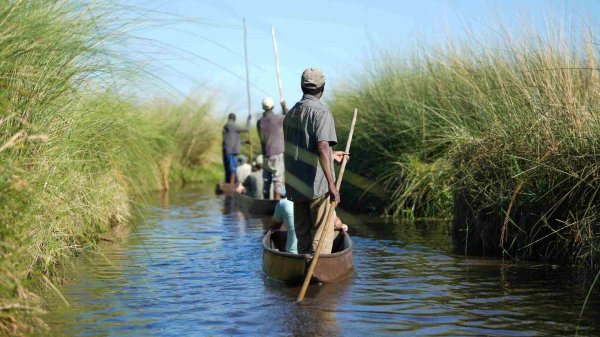
The wetlands of the Okavango make for incredibly serene, but more time consuming, safaris
The landscapes in the two reserves also vary. Chobe’s dry woodlands and savannahs contrast sharply with the lush, water-filled environment of the Delta. And while Chobe is known for its elephants, the Delta offers sightings of species like sitatunga antelope and aquatic birds not commonly found in Chobe.
Botswana's two prime nature reserves are so different that most travellers with ample time will choose to visit both and enjoy an incredibly comprehensive safari experience—see how we do that on our Wilderness Escape Tour.
> Read More: All You Need to Know About Visiting the Okavango Delta
Getting to Chobe is a hot breeze. Most choose to fly into Kasane, which has regular connections to Johannesburg, Victoria Falls, and Maun. It's a short drive from the airport to the park's main gate.
A road transfer is a popular option for those coming from Victoria Falls or Livingstone. The journey takes about an hour, and border crossings are straightforward. If you're travelling from Namibia, the Ngoma Gate provides access to the park via the Caprivi Strip.
For the more adventurous, flying into one of the park’s remote airstrips opens up possibilities for exploring remote regions like Savuti and Linyanti.
> Read More: Tips for Planning a Multi-Country African Safari
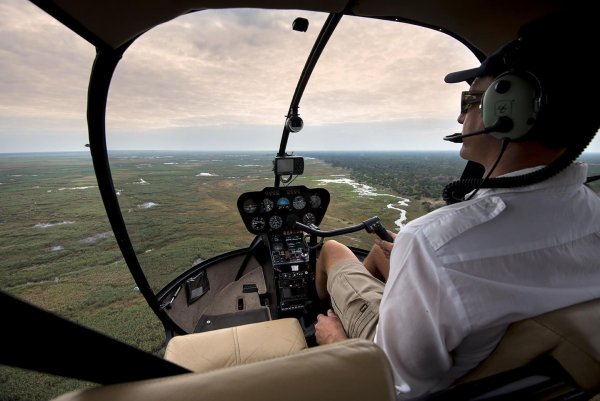
Some of Chobe’s remotest game lodges are not accessible by road and and can only be reached by small plane.
Chobe offers a wealth of accommodation choices, both within the park's boundaries and just outside its gates. Those inside the park are typically more expensive but they also offer a more immersive stay and are usually more luxurious.
For those with a keen eye for luxury, lodges like Chobe Game Lodge or Ngoma Safari Lodge provide world-class service and impeccable amenities.
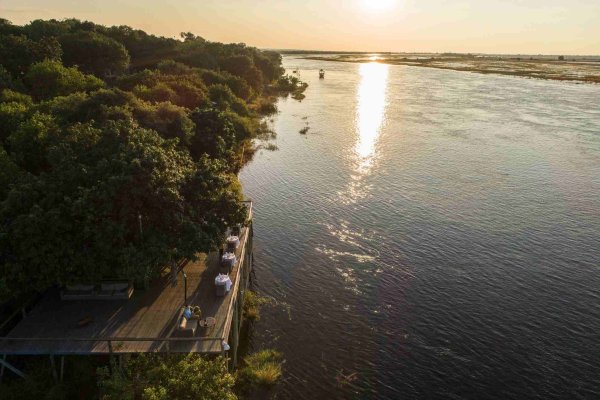
The Chobe Game Lodge is a dream lodge, sitting on the shores of the river.
The Chobe Elephant Camp is one of our favourite great-value options and arguably better than the budget alternatives in Kasane. You get to stay overnight just outside the park’s boundaries, overlooking the river and floodplains.
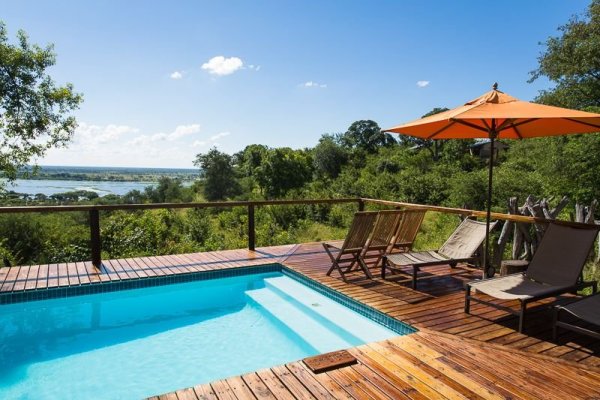
> Read more: 6 Tips to Stretch Your Budget on an African Safari
And then there’s the Zambezi Queen for the ultimate safari experience. This luxury riverboat is essentially a floating safari lodge, with gorgeous and spacious suites, incredible dining, and sensational views of the Chobe River. Gliding along the river on this Queen, immersed in the sounds of nature and spotting wildlife, is a bucket-list experience of its own accord.
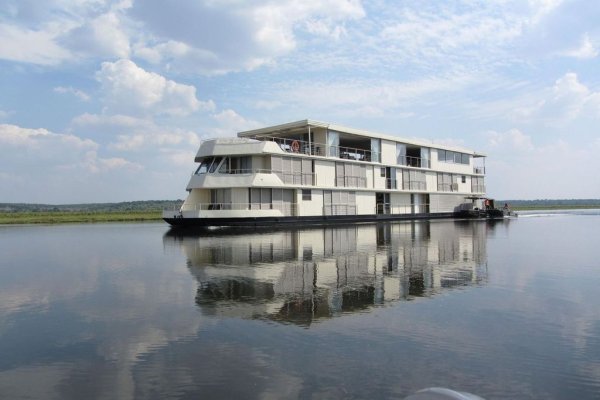
If you’d love to include a multi-day Chobe National Park safari or even just a Chobe day trip on your visit to Africa, reach out to our Destination Speicalists. They’ll help you figure out how to slide this exceptional destination into your itinerary and will happily offer pointers on how to best plan your journey.
At Viva Expeditions we’re here to make your Africa safari dreams come true! Contact us today.
Laura PattaraLaura Pattara has guided overland trips across Africa and now focuses her writing on the continent for Viva Expeditions. She once camped beneath a marula tree that an elephant tore apart during the night, yet somehow she still sleeps best in a tent. But make it glam! From sunrise balloon rides over the Serengeti to following the rhythms of wildlife migrations, Laura brings the wild heart of Africa to life with warmth, depth, and the occasional muddy boot. |

An unforgettable adventure where you'll experience the spectacular Victoria Falls, enjoy an up-close elephant encounter, and explore renowned Chobe!
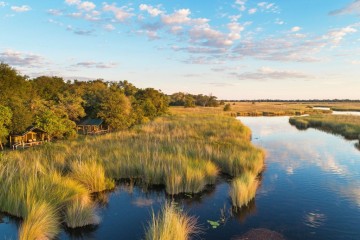
Explore the untamed splendor of Botswana with our 5-night Fly-Around Safari. Explore the highlights of Moremi Game Reserve and Chobe National Park.
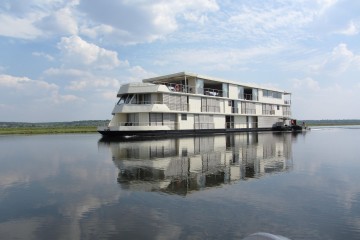
Small Ship Cruising: Small ship expedition cruises are a wonderful way to explore. Choose from Antarctica cruises & Sub-Antarctic Island cruises, Arctic cruises or sail the Patagonian Fiords, Galapagos Islands Cruising or New Zealand’s wonderful Fiordland.
Unique Stays: Explore a world of extraordinary experiences with our Unique Stays, each tailored to enrich your journey with unforgettable adventures and authentic encounters.
A luxurious truly unique river safari, where you’ll enjoy exhilarating wildlife adventures and breathtaking views of the Chobe River.